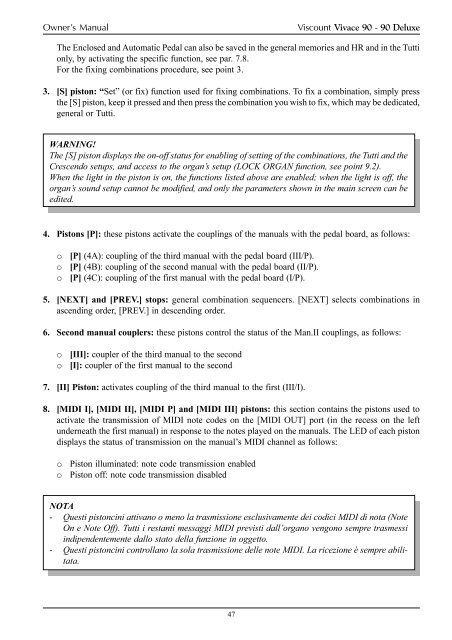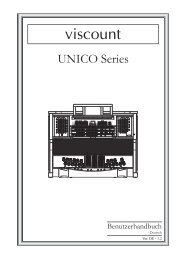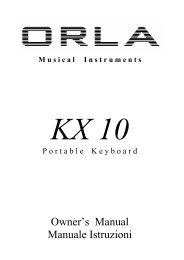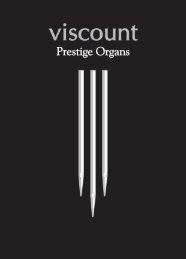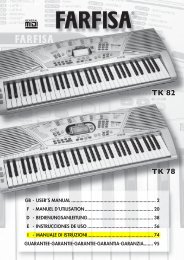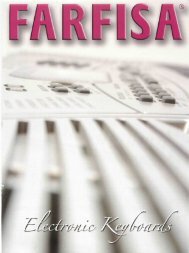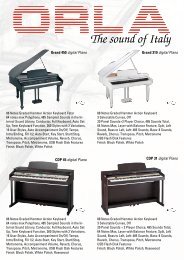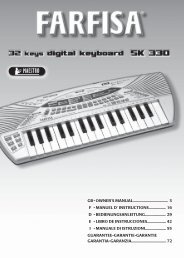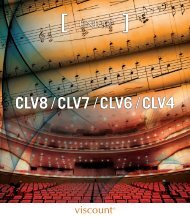You also want an ePaper? Increase the reach of your titles
YUMPU automatically turns print PDFs into web optimized ePapers that Google loves.
Owner’s Manual<br />
<strong>Viscount</strong> Vivace 90 - 90 Deluxe<br />
The Enclosed and Automatic Pedal can also be saved in the general memories and HR and in the Tutti<br />
only, by activating the specific function, see par. 7.8.<br />
For the fixing combinations procedure, see point 3.<br />
3. [S] piston: “Set” (or fix) function used for fixing combinations. To fix a combination, simply press<br />
the [S] piston, keep it pressed and then press the combination you wish to fix, which may be dedicated,<br />
general or Tutti.<br />
WARNING!<br />
The [S] piston displays the on-off status for enabling of setting of the combinations, the Tutti and the<br />
Crescendo setups, and access to the organ’s setup (LOCK ORGAN function, see point 9.2).<br />
When the light in the piston is on, the functions listed above are enabled; when the light is off, the<br />
organ’s sound setup cannot be modified, and only the parameters shown in the main screen can be<br />
edited.<br />
4. Pistons [P]: these pistons activate the couplings of the manuals with the pedal board, as follows:<br />
o<br />
o<br />
o<br />
[P] (4A): coupling of the third manual with the pedal board (III/P).<br />
[P] (4B): coupling of the second manual with the pedal board (II/P).<br />
[P] (4C): coupling of the first manual with the pedal board (I/P).<br />
5. [NEXT] and [PREV.] stops: general combination sequencers. [NEXT] selects combinations in<br />
ascending order, [PREV.] in descending order.<br />
6. Second manual couplers: these pistons control the status of the Man.II couplings, as follows:<br />
o<br />
o<br />
[III]: coupler of the third manual to the second<br />
[I]: coupler of the first manual to the second<br />
7. [II] Piston: activates coupling of the third manual to the first (III/I).<br />
8. [MIDI I], [MIDI II], [MIDI P] and [MIDI III] pistons: this section contains the pistons used to<br />
activate the transmission of MIDI note codes on the [MIDI OUT] port (in the recess on the left<br />
underneath the first manual) in response to the notes played on the manuals. The LED of each piston<br />
displays the status of transmission on the manual’s MIDI channel as follows:<br />
o<br />
o<br />
Piston illuminated: note code transmission enabled<br />
Piston off: note code transmission disabled<br />
NOTA<br />
- Questi pistoncini attivano o meno la trasmissione esclusivamente dei codici MIDI di nota (Note<br />
On e Note Off). Tutti i restanti messaggi MIDI previsti dall’organo vengono sempre trasmessi<br />
indipendentemente dallo stato della funzione in oggetto.<br />
- Questi pistoncini controllano la sola trasmissione delle note MIDI. La ricezione è sempre abilitata.<br />
47


